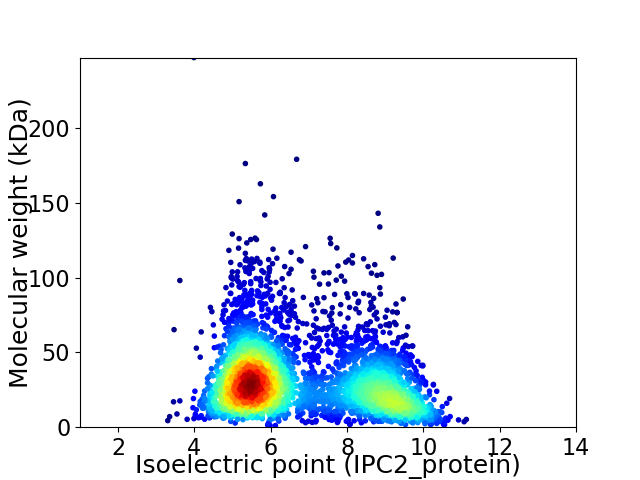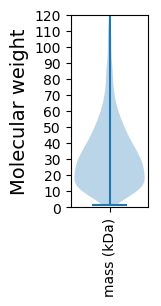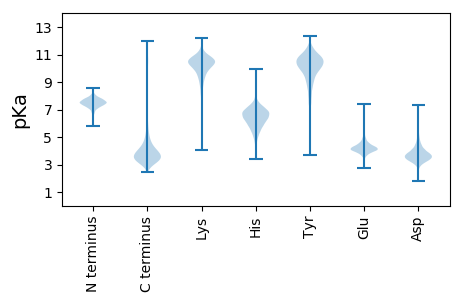
Caulobacter vibrioides (strain NA1000 / CB15N) (Caulobacter crescentus)
Taxonomy: cellular organisms; Bacteria; Proteobacteria; Alphaproteobacteria; Caulobacterales; Caulobacteraceae; Caulobacter; Caulobacter vibrioides
Average proteome isoelectric point is 6.78
Get precalculated fractions of proteins

Virtual 2D-PAGE plot for 3859 proteins (isoelectric point calculated using IPC2_protein)
Get csv file with sequences according to given criteria:
* You can choose from 21 different methods for calculating isoelectric point
Summary statistics related to proteome-wise predictions



Protein with the lowest isoelectric point:
>tr|A0A0H3CAZ9|A0A0H3CAZ9_CAUVN Tetratricopeptide repeat-containing 2OG-Fe(II) oxygenase OS=Caulobacter vibrioides (strain NA1000 / CB15N) OX=565050 GN=CCNA_02909 PE=4 SV=1
MM1 pKa = 7.15SAEE4 pKa = 4.13PFKK7 pKa = 10.98VWQCRR12 pKa = 11.84TCGYY16 pKa = 10.22IYY18 pKa = 10.38DD19 pKa = 4.58EE20 pKa = 4.41EE21 pKa = 4.52QGDD24 pKa = 4.14PGEE27 pKa = 4.38GLAPGTRR34 pKa = 11.84WADD37 pKa = 3.25IPAGWVCPLCGTPKK51 pKa = 10.44SDD53 pKa = 3.9FDD55 pKa = 4.21MIEE58 pKa = 3.7LL59 pKa = 3.99
MM1 pKa = 7.15SAEE4 pKa = 4.13PFKK7 pKa = 10.98VWQCRR12 pKa = 11.84TCGYY16 pKa = 10.22IYY18 pKa = 10.38DD19 pKa = 4.58EE20 pKa = 4.41EE21 pKa = 4.52QGDD24 pKa = 4.14PGEE27 pKa = 4.38GLAPGTRR34 pKa = 11.84WADD37 pKa = 3.25IPAGWVCPLCGTPKK51 pKa = 10.44SDD53 pKa = 3.9FDD55 pKa = 4.21MIEE58 pKa = 3.7LL59 pKa = 3.99
Molecular weight: 6.54 kDa
Isoelectric point according different methods:
Protein with the highest isoelectric point:
>tr|A0A0H3CB03|A0A0H3CB03_CAUVN Fumarylacetoacetase superfamily protein OS=Caulobacter vibrioides (strain NA1000 / CB15N) OX=565050 GN=CCNA_02614 PE=4 SV=1
MM1 pKa = 7.54PFGWPLHH8 pKa = 6.05RR9 pKa = 11.84RR10 pKa = 11.84SAVPLPRR17 pKa = 11.84WGRR20 pKa = 11.84RR21 pKa = 11.84GVRR24 pKa = 11.84RR25 pKa = 11.84GQISRR30 pKa = 11.84SS31 pKa = 3.47
MM1 pKa = 7.54PFGWPLHH8 pKa = 6.05RR9 pKa = 11.84RR10 pKa = 11.84SAVPLPRR17 pKa = 11.84WGRR20 pKa = 11.84RR21 pKa = 11.84GVRR24 pKa = 11.84RR25 pKa = 11.84GQISRR30 pKa = 11.84SS31 pKa = 3.47
Molecular weight: 3.67 kDa
Isoelectric point according different methods:
Peptides (in silico digests for buttom-up proteomics)
Below you can find in silico digests of the whole proteome with Trypsin, Chymotrypsin, Trypsin+LysC, LysN, ArgC proteases suitable for different mass spec machines.| Try ESI |
 |
|---|
| ChTry ESI |
 |
|---|
| ArgC ESI |
 |
|---|
| LysN ESI |
 |
|---|
| TryLysC ESI |
 |
|---|
| Try MALDI |
 |
|---|
| ChTry MALDI |
 |
|---|
| ArgC MALDI |
 |
|---|
| LysN MALDI |
 |
|---|
| TryLysC MALDI |
 |
|---|
| Try LTQ |
 |
|---|
| ChTry LTQ |
 |
|---|
| ArgC LTQ |
 |
|---|
| LysN LTQ |
 |
|---|
| TryLysC LTQ |
 |
|---|
| Try MSlow |
 |
|---|
| ChTry MSlow |
 |
|---|
| ArgC MSlow |
 |
|---|
| LysN MSlow |
 |
|---|
| TryLysC MSlow |
 |
|---|
| Try MShigh |
 |
|---|
| ChTry MShigh |
 |
|---|
| ArgC MShigh |
 |
|---|
| LysN MShigh |
 |
|---|
| TryLysC MShigh |
 |
|---|
General Statistics
Number of major isoforms |
Number of additional isoforms |
Number of all proteins |
Number of amino acids |
Min. Seq. Length |
Max. Seq. Length |
Avg. Seq. Length |
Avg. Mol. Weight |
|---|---|---|---|---|---|---|---|
0 |
1213672 |
10 |
2479 |
314.5 |
33.86 |
Amino acid frequency
Ala |
Cys |
Asp |
Glu |
Phe |
Gly |
His |
Ile |
Lys |
Leu |
|---|---|---|---|---|---|---|---|---|---|
13.867 ± 0.063 | 0.735 ± 0.013 |
5.781 ± 0.031 | 5.422 ± 0.039 |
3.583 ± 0.024 | 8.856 ± 0.032 |
1.753 ± 0.02 | 4.417 ± 0.026 |
3.561 ± 0.031 | 10.034 ± 0.048 |
Met |
Asn |
Gln |
Pro |
Arg |
Ser |
Thr |
Val |
Trp |
Tyr |
|---|---|---|---|---|---|---|---|---|---|
2.285 ± 0.018 | 2.395 ± 0.029 |
5.471 ± 0.033 | 3.161 ± 0.026 |
7.134 ± 0.043 | 5.106 ± 0.032 |
5.294 ± 0.048 | 7.568 ± 0.034 |
1.431 ± 0.016 | 2.144 ± 0.02 |
Most of the basic statistics you can see at this page can be downloaded from this CSV file
Proteome-pI is available under Creative Commons Attribution-NoDerivs license, for more details see here
| Reference: Kozlowski LP. Proteome-pI 2.0: Proteome Isoelectric Point Database Update. Nucleic Acids Res. 2021, doi: 10.1093/nar/gkab944 | Contact: Lukasz P. Kozlowski |
